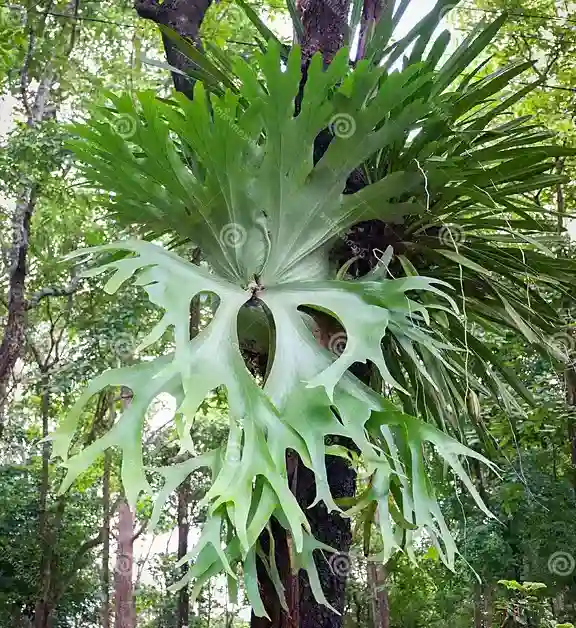Platycerium coronarium, commonly known as the Crown Fern, is a remarkable plant renowned for its distinct appearance and unique characteristics.
This plant is characterized by its highly lobed and thick shield fronds, which are light green, waxy, and adorned with protruding veins, giving it a regal crown-like appearance.
The fertile fronds of Platycerium coronarium are long and twisted, bearing spore patches on the underside of kidney-shaped lobes. The plant exhibits considerable variation in size, with reports of both extremely wide and extremely narrow fertile fronds.

Native to regions such as Thailand, Malaysia, and Singapore, this resilient plant has adapted to different climatic conditions. In cool temperature areas, it necessitates drying out before colder temperatures, while in high humidity regions like Taiwan and Malaysia, it thrives in temperatures above 80 degrees.
Platycerium coronarium reproduces through rhizome growth and can form rings around the host tree. Its ability to attract ants, which provide protein and minerals, adds to its intriguing nature.
This article delves into the appearance, characteristics, growing requirements, and natural habitat and distribution of Platycerium coronarium.
Key Takeaways
- Platycerium coronarium has highly lobed and thick shield fronds.
- The plant has long and twisted fertile fronds with spore patches on the underside of kidney-shaped lobes.
- It can be difficult to grow in America, but once established, it is a tough plant.
- Platycerium coronarium attracts ants, which provide protein and minerals for the plant.
Appearance and Characteristics
Platycerium coronarium is characterized by its highly lobed and thick shield fronds, which have a light green color, waxy texture, and protruding veins.

These shield fronds, measuring approximately 1.2 cm in thickness, give the plant its name due to their crown-like appearance.
The fertile fronds of P. coronarium can grow up to 12 ft in length and form a long and twisted mass.
On the concave underside of the kidney-shaped lobes of these fertile fronds, spore patches can be found.
It is interesting to note that the spore patches tend to fall off in a large patch, although the reason behind this phenomenon remains unknown.
This plant is known for attracting ants, which provide necessary protein and minerals.
Despite being difficult to grow in some areas, Platycerium coronarium is a resilient species once established.
[youtube width=630 height=550]os481B0AWIw[/youtube]
Growing Requirements of Platycerium coronarium
To successfully cultivate Platycerium coronarium, it is important to provide appropriate growing conditions that meet its specific requirements. This includes proper watering techniques and soil requirements.
Watering techniques:
- Platycerium coronarium prefers to be kept slightly moist but not overly wet.
- Avoid overwatering as this can lead to root rot and damage the delicate shield fronds.
- Water the plant thoroughly, allowing excess water to drain away, but ensure the soil is not waterlogged.
Soil requirements:
- Platycerium coronarium thrives in a well-draining medium that retains some moisture.
- A recommended soil mix consists of equal parts peat moss, perlite, and orchid bark.
- The soil should be slightly acidic, with a pH range of 5.5 to 6.5.
- Adding organic matter, such as leaf litter or compost, can help improve soil fertility and moisture retention.
By following these watering and soil requirements, enthusiasts can create optimal conditions for the successful growth of Platycerium coronarium.
Natural Habitat and Distribution
The natural habitat and distribution of Platycerium coronarium extends throughout Thailand, Malaysia, and Singapore. It is commonly found in high humidity environments and frequent rain showers. This plant species is native to these regions and plays an important ecological role in these ecosystems.
Platycerium coronarium is known to grow on trees and rocks, often forming colonies. It has a unique adaptation to its environment, with its shield fronds acting as a canopy to protect the plant from excessive sunlight and to retain moisture.
The plant’s ability to attract ants also contributes to its ecological role, as these insects provide protein and minerals through their interactions with the plant.
Overall, Platycerium coronarium is well-suited to its native range and has an important place within the ecosystems of Thailand, Malaysia, and Singapore.
FAQ’s about Platycerium coronarium
How do ants contribute to the growth and health of Platycerium coronarium?
Ant plant symbiosis is a mutualistic relationship where ants contribute to the growth and health of plants. Ants provide protein and minerals through their waste, protect plants from herbivores, and aid in seed dispersal, ultimately benefiting plant nutrition, defense, and reproduction.
What is the reason behind the spore patches falling off in a large patch?
The reason behind the spore patches falling off in a large patch in Platycerium coronarium is currently unknown. However, ants play a role in the growth and health of the plant by providing protein and minerals.
Are there any specific methods or techniques to control the rhizome growth of Platycerium coronarium?
Methods and techniques to control rhizome growth in Platycerium coronarium include using wire baskets or boards to plan for growth. Factors such as ants contribute to the growth and health of the plant. Overwatering in high humidity environments can affect the growth and health of Platycerium coronarium.
What factors determine the traits and size of the dwarf Platycerium coronarium?
Factors such as genetic variations, environmental conditions (including temperature, humidity, and light), and cultural practices like watering and fertilization can influence the traits and size of the dwarf Platycerium coronarium. Further research is needed to fully understand these factors.
How does overwatering in high humidity environments affect the growth and health of Platycerium coronarium?
Overwatering in high humidity environments can negatively affect the growth and health of Platycerium coronarium. It can lead to root rot and hinder nutrient uptake, as excessive moisture creates an anaerobic environment and disrupts the balance of beneficial microorganisms in the soil.













Comments are closed.